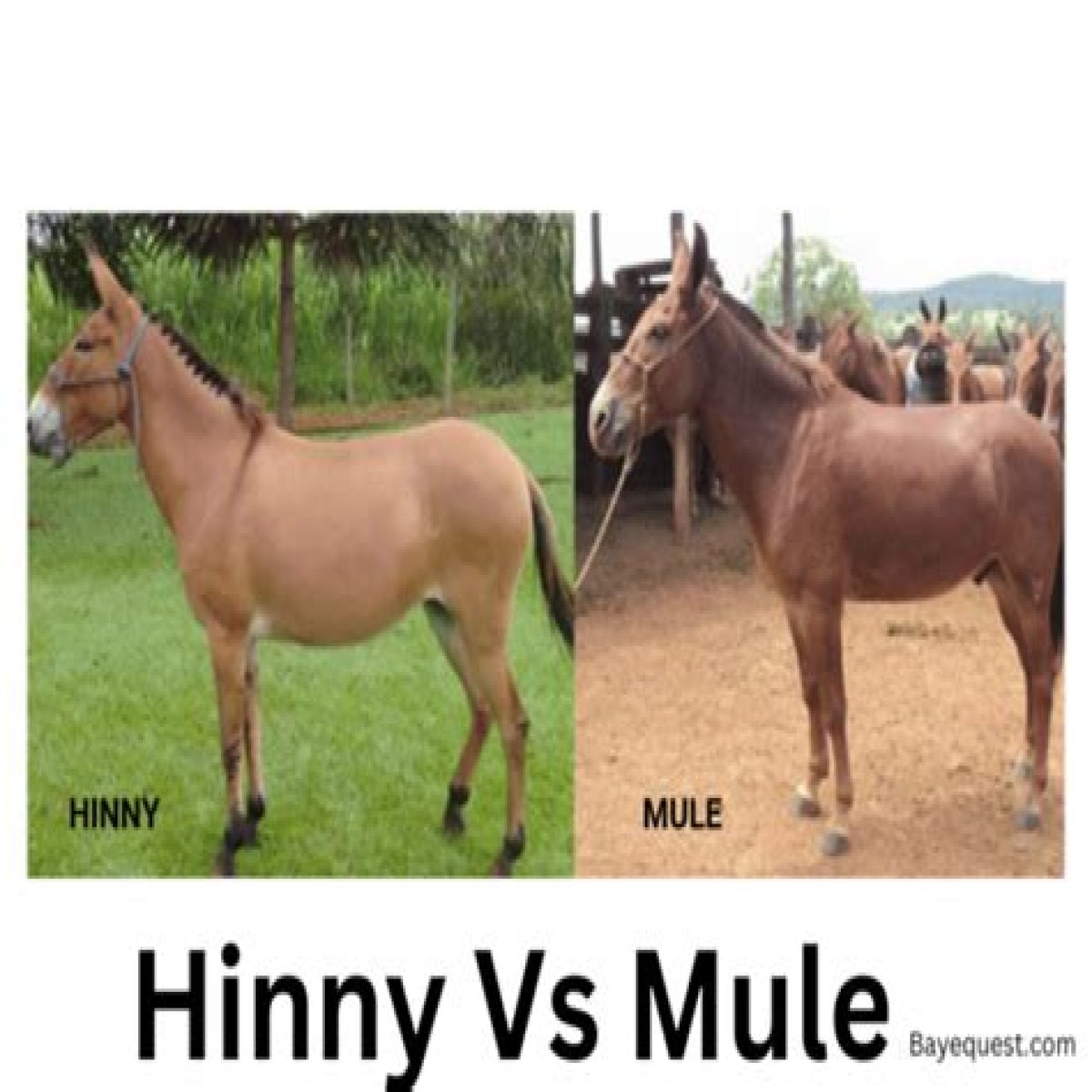Even though hinnies and mules have a horse as a parent, they are not called horses. However, the genus Equus includes hinnies, donkeys, horses, and mules. Hinnies and Mules are produced from two separate species because donkeys are likewise not horses. Hinnies and Mules are frequently selectively bred to achieve the ideal blend of donkey and horse characteristics.
Mule vs Hinny
The main difference between mule and hinny lies in several factors, such as how they are born, they are born due to mating of which set of animals. They also possess differences in exhibiting stamina, characteristics of hybrid vigour, whose body they are similar to, possessing similar ears to whom and the basic differences in their Characteristics and behaviours.
Mules are significantly larger than Hinnies. Mules’ bodies have similar structural qualities to horses’ bodies. Mules have ears that are similar to those of a donkey. Mules, in comparison to horses, are often quick learners and consequently highly clever, courageous, and calm. They can be difficult and sensitive until they gain trust in their owner. Aside from that, they’re recognised for being loyal, affectionate, and lively.
The Hinnies’ physique is far too similar to those of donkeys. Hinnies have smaller ears than horses. In comparison to Mules, Hinnies are known to be more sensitive, stubborn, and reserved, as they inherit the temperament and characteristics of donkeys. They become less adventurous and more docile, submissive, and prone to spooking when they eventually trust their owners.
Comparison Table Between Mule and Hinny
What is Mule?
When a male donkey named Jack mates with a female horse or mare, a mule is produced. Mules have higher endurance than Hinnies. Mules are larger than Hinnies in comparison.
Mules are known for having better attributes than either of their parents, which is why they are referred to as hybrid vigour. Mules’ bodies are comparable to horses’ bodies in terms of structural qualities. Mules have longer ears, which are similar to those of a donkey.
Mules, in comparison to horses, are often rapid learners and consequently intelligent, courageous, and calm. However, until they gain trust in their owner, they can be difficult and sensitive. Aside from that, they’re recognised for being devoted, affectionate, and lively.
Though hinnies and mules have a horse as a parent, they are not horses. Horses, donkeys, and mules, on the other hand, are all members of the Equus genus, including hinnies.
What is Hinny?
When a female donkey or jenny is mated with a male horse or stallion, the result is a hinny. In comparison to mules, hinnies have lower stamina. Hinnies typically inherit certain traits from their parents and hence lack hybrid vigour.
In terms of size and look, Hinnies are usually smaller than Mules. The Hinnies’ bodies resemble those of donkeys far too closely. Hinnies have smaller ears, which are akin to those of horses.
Because they inherit the temperament and characteristics of donkeys, Hinnies are known to be more sensitive, stubborn, and reserved than Mules. They become less daring, more peaceful, docile, and prone to spooking once they have gained their owners’ trust.
Hinnies and mules are bred from two separate species, as donkeys are not horses. Hinnies and mules are frequently bred for the optimum combination of donkey and horse characteristics.
Main Differences Between Mule and Hinny
- A mule is born when the mating between a male donkey, known as Jack and a female horse or mare is done. On the other hand, a hinny is born when a jenny or a female donkey is being mated with a male horse or stallion.
- Mules exhibit comparatively more stamina than Hinnies. On the other hand, Hinnies exhibit comparatively less stamina than mules.
- Mules have usually possessed those types of qualities that are superior to either of their parents and hence, considered as hybrid vigour. On the other hand, Hinnies usually possess some inherited qualities from their parents, therefore do not possess much hybrid vigour.
- Mules are comparatively bigger than Hinnies. On the other hand, Hinnies are usually smaller than Mules in terms of size and appearance.
- The bodies of the Mules possess similar structural characteristics in terms to the bodies of horses. On the other hand, the body of the Hinnies is too similar to the bodies of the donkeys.
- Mules exhibit donkey-like longer ears. On the other hand, Hinnies exhibit horse-like smaller ears.
- Mules are generally quick learners and are thus, highly intelligent, bold and calm in comparison to the horses. However, they can be very stubborn and sensitive also until they trust their master. Otherwise, they are known for their loyal, affectionate and playful characteristics. On the other hand, Hinnies are known to be more sensitive, stubborn and reserved in comparison to Mules, as they inherit the temperament and properties of donkeys. When they finally trust their masters, they become less adventurous and more quiet, compliant and prone to spooking.
Conclusion
The distinction between a mule and a hinny can be found in a variety of ways, including how they are born and which pair of animals they are born from. They also differ in terms of displaying stamina, hybrid vigour features, whose physique they resemble, who they have similar ears too, and the fundamental differences in their characteristics and behaviours.
When a male donkey, known as Jack, and a female horse or mare are mated, a mule is produced. Mules have a higher stamina level than Hinnies. Mules have typically possessed traits that are superior to either of their parents and so are referred to as hybrid vigour.
When a jenny or a female donkey is coupled with a male horse or stallion, a hinny is born. Hinnies have a lower stamina level than mules. Hinnies normally inherit certain traits from their parents, thus they don’t have a lot of hybrid vigour. In terms of size and look, Hinnies are typically smaller than Mules.
